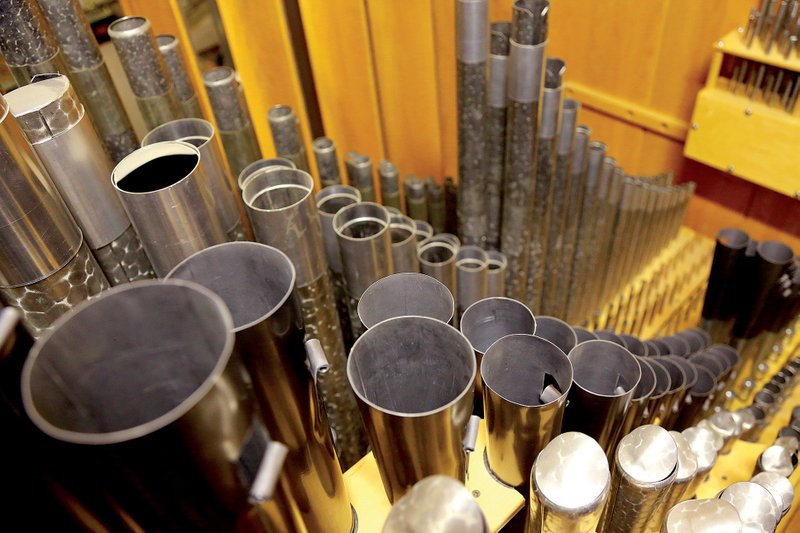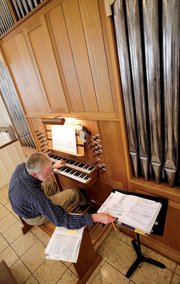LITTLE ROCK — Despite the dominance in contemporary worship of praise bands with their electric and acoustic guitars and drums, the pipe organ endures.
Pipe organs are expensive and require regular maintenance, but for some worship isn’t the same without the majestic instruments.
The massive 3,300-plus pipe organ at First United Methodist Church in downtown Little Rock fills the historic sanctuary with sound, from delicate, trembling high notes to tones so deep the resulting rumble can be felt. The pipes, some as small as a drinking straw, gradually increase up to 32 feet tall. But they are hidden from view, enclosed behind a facade that blends into the decor of the room. Only the console, with its keyboards and many knobs and foot pedals, is visible.
Built in 1985, the organ was installed by Casavant Freres, a company in Quebec. Church organist John Churchwell said the organ cost about $287,000 and the church has spent an additional $100,000 on improvements by Nichols & Simpson Inc. Organ builders of Little Rock.
The organ has 57 ranks with 43 stops. Ranks refers to the number of pipe sets, while stops are the mechanisms used to control air flow to each set of pipes.
Churchwell said if built today, the organ would cost about $1.5 million.
“Organs are still very relevant but very cost prohibitive,” Churchwell said. “That’s a big issue for churches that get rid of their organs - the cost of building one and maintaining it.”
The church, which has weekly attendance of about 400, has a yearly budget of $4,000 for tuning the organ, but if something breaks down, the cost can skyrocket.
“If there are larger issues, like re-leathering the wind chests, that would be over $150,000 or if the fan blower were to be replaced, that would be $25,000,” Churchwell said.
The church is considering replacing the organ console, which would be about $130,000.
These are costs that most smaller churches can’t afford.
ON LOAN
Grace Episcopal Church in Siloam Springs, with average attendance of about 150, wouldn’t normally be able to afford a large pipe organ. However, the congregation benefits from a unique arrangement that allows for free use of a pipe organ.
The organ in the back of the nave or sanctuary doesn’t belong to the congregation. It’s owned by Ernest Whitmore, an organist and an instructor at John Brown University who lives nearby and wanted a pipe organ for his home. His plans for remodeling his home to accommodate the organ he commissioned didn’t work out and he needed a place to store it.
“It’s now here in perpetuity,” said Jan Wubbena, organist at the church since 1977. “He pays no rent for organ storage and we pay no rent for organ use. It works out really well.”
The church’s previous organ was a small, eight-stop one. The Whitmore organ, which was built by Steven Cheyne-Cook in Seattle, is much larger with about 1,100 pipes. Wubbena said it’s the largest pipe organ in Siloam Springs.
“It’s a perfect fit for this room,” Wubbena said. “We really think it was the hand of God that this was destined to be. It certainly has supported our congregational singing to an extent that the little organ never could do.”
Wubbena said Whitmore is a night owl and often stops by the church at night to play. He serves as organist at First United Methodist Church in Siloam Springs and at Peace Lutheran Church in Rogers.
Pipe organs in one form or another have been around since about 200 B.C. and over the centuries became standard fare in churches but could be found in many venues.
“At one point the organ was everywhere,” Churchwell said. “Auditoriums, theaters, churches and even homes.”
Anthony Thurman, director of development for the American Guild of Organists headquartered in New York, said around the turn of the 20th century “no self-respecting orchestra would build a concert hall without a pipe organ.” But over the years the pipe organ seemed to lose favor and some venues, including Carnegie Hall, removed their pipe organs.
ORGAN REVIVAL
Thurman said he has seen a revival of sorts in recent years with concert halls around the country installing new pipe organs.
“In the last 20 years more organs have been built for American concert halls that any other time in history,” he said. “We’re talking multimillion dollar organs in addition to the organs in the church, which have been the backbone of church music for hundreds of years.”
In a church setting, a pipe organ supports congregational singing better than any other instrument, Thurman said.
“If you play a note on a pipe organ and hold it you can hold it forever,” he said. “The sound stays constant and sets up a rolling sound wave. For people singing, the sound of an organ surrounds them and stays with them. Any other instrument, the piano, the guitar, doesn’t have that sustaining quality.”
Thurman said interest in pipe organs is alive and well and the guild works to attract students through a variety of programs, including summer Pipe Organ Encounters. Hundreds of beginning organ students as well as those with no experience attend programs to learn about the instruments, receive lessons and give recitals.
“We don’t see the demise of the organ at all, in churches or in secular settings,” he said.
What he has seen is that colleges and universities have been cutting back organ departments, sometimes shuttering them, such as at the University of Louisville in Kentucky and Northwestern University in Evanston, Ill.
“It’s an expensive program to run for a few students,” he said. “The world is full of people who play the flute, the clarinet or the trumpet, but when you talk about the organ, the harp or the bassoon with not as many people playing, then colleges and universities see that as a more expensive program to support.”
However, strong organ programs are available across the country, from the Yale Institute of Sacred Music to the University of California at Los Angeles, he said.
As for Churchwell, he began playing the organ at 13 with the encouragement of his piano teacher, who was also a church organist.
“She knew the importance of creating a new generation of organists,” he said.
LEARNING CURVE
Churchwell said it took time to master the instrument.
“It takes about two years to really understand a large pipe organ,” he said. “A lot of churches have electric organs but nothing compares to the feel of a pipe organ.”
Through the years, Churchwell said, he has learned that each pipe organ has its own character. At the same time, each congregation also has its own personality.
“You have to learn the character of the church, to feel the energy of how fast or slow the congregations like their music, how loud or soft they want it,” he said. “We’re fortunate to have a congregation that sings well on hymns.”
The organ at the Methodist church is electro-pneumatic, meaning that it uses a combination of electricity and mechanics to send a signal to the pipes where a magnet is opened allowing sound to be produced. The organ at Grace Episcopal is manually operated on what’s often called a tracker system. The only electrical component is a blower to pressurize the air that is fed into a reservoir and kept under constant pressure until a key is depressed, stops are opened and it can escape to produce sound through the pipe.
Wubbena said before the advent of electricity organists had to recruit someone to pump the bellows to provide air pressure.
The organist said he grew up attending a church that had a small electric organ that “was not very appealing.” He began playing piano in the third grade but never gave much thought to the organ - that is, until he changed churches in high school.
“They had a pipe organ. It wasn’t very big but it sure was different from what I was used to,” he said. “The very first time I walked in there and heard the opening it was ‘Oh, goodness! This is magnificent.’ There’s nothing like it.”
His piano teacher, who was organist at the church, recognized his interest and began teaching him how to play the pipe organ and he never looked back.
“There’s never been any question since then,” he said. “I have three degrees and all of them are in the organ.”
For Wubbena, who plays in a liturgical church with a musical repertoire that spans centuries, a praise band isn’t needed.
“In our tradition we claim all the music of the Western church and then some,” he said. “If it’s still around, it’s because it speaks to us. It has meaning for us and I see no reason to abandon it.”
Churchwell said his church has seen an increase in weddings, oftentimes couples who attend contemporary-style churches with praise band music. They come seeking a traditional setting, complete with a pipe organ.
“They love the praise band worship but they want that traditional music for their wedding,” he said. “The organ at First United Methodist really sells the environment.”
For Churchwell, nothing compares to the sound of a pipe organ.
“The sounds and character and feel of the pipe organ are like no other instrument. That is why it’s called ‘the king of instruments,’” he said.
Religion, Pages 12 on 02/02/2013


